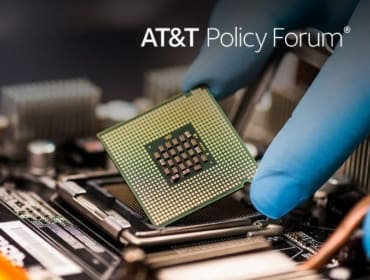Global semiconductor supply chain constraints are widespread and are profoundly impacting businesses across many industries. Recovery will be complicated as production cycles are lengthy and the materials used for semiconductor manufacturing, assembly and packaging are scarce. Lack of access to certain materials like rare minerals can create another bottleneck in the process to bring semiconductors to market.
Policy development in the area of global trade, which may have seemed far flung previously, is now critical in the semiconductor sector as well as the overall ICT supply.
Learn more about supply chain challenges and discussions happening within the administration, in industry, and on Capitol Hill.
The event featured a fireside chat with Bruce Stokes, Non-Resident Transatlantic Fellow, The German Marshall Fund of the United States and Peter Harrell, Senior Director for International Economics and Competitiveness, White House National Security Council.
The fireside chat was followed by remarks by Susan Johnson, EVP, Global Connections and Supply Chain, AT&T.
The event concluded with a panel discussion, featuring:
- Steven Overly, Global Trade & Economics Reporter, POLITICO (Moderator)
- Chris Netram, VP, Tax and Domestic Economic Policy, National Association of Manufacturers (NAM)
- Tom Quillin, Senior Director, Governments Markets & Trade, Intel Corporation
- Claire Sanderson, Legislative Assistant, Senator John Cornyn (TX)
Event Recap
In a recent AT&T Policy Forum event, experts from across industries discussed the current semiconductor supply chain challenge. Participants explored the economic and geopolitical factors shaping the present-day constraints and offered potential policy solutions to help alleviate today’s supply shortages and help prevent them in the future.
In the opening fireside chat Peter Harrell, Senior Director for International Economics and Competitiveness at the White House National Security Council, emphasized to Bruce Stokes, Non-Resident Transatlantic Fellow at The German Marshall Fund of the United States, the priority that the Administration is placing on the semiconductor chip shortage. He pointed to two different work streams: long-term and short-term actions.
Harrell said in the short term there aren’t many easy solutions to help scale capacity. The lack of short-term solutions reinforces the notion that long-term fixes and sustainable policy is critical to ensure the shortage does not happen again. However, Harrell did point to the Administration’s work with companies to raise their capacity and increase transparency across the supply chain to enable better planning and minimize business disruption.
Harrell also discussed the Administration’s support for the CHIPS Act and highlighted the importance of funding for R&D and workforce training as ways to ensure a successful semiconductor supply chain. He also noted how important it is to work with allies to ensure that as we craft and implement policy in the U.S, we do so in way that creates cooperation, not competition, globally.
Following the fireside chat, Susan Johnson EVP, Global Connections and Supply Chain at AT&T spoke on the potential impact of supply chain constraints on AT&T and the industry at large, noting the shortage is “more structural and longer term in nature,” than others the industry has faced. She detailed the difficulty to solve the issue due to the expense of building more semiconductor fabs, challenges posed by the over-concentration of manufacturing in regions prone to natural disasters and geopolitical tension, and the shortage of skilled workers. Johnson also emphasized the risk of geographic concentration, offering that industry experts and governments must collaborate to facilitate investments to drive more geographic diversity and ensure supply chain resiliency. In exploring these unique challenges, she echoed Harrell and stressed that while there was no quick fix, the industry and government must work together to find solutions and create a stronger industry for the future.
Finally, Steven Overly, Global Trade & Economics Reporter at POLITICO moderated a panel discussion with industry leaders who have both felt the pressures of the semiconductor chip shortage and are working to solve it.
Tom Quillin, Senior Director, Governments Markets & Trade at Intel Corporation amplified previous comments about finding long-term solutions. He highlighted the Administration’s work to increase the pace of U.S. innovation. Chris Netram, VP, Tax and Domestic Economic Policy at National Association of Manufacturers also mentioned the need for structural reforms to ensure we have a strong supply chain as the industry continues to evolve, and as consumer demand continues to grow in the U.S. and across the world. Claire Sanderson, Legislative Assistant, Senator John Cornyn (R-TX) emphasized the bipartisan support in Congress for finding a solution to the chips shortage and the importance of funding the CHIPS Act.
All participants emphasized the Administration, industry, and other key stakeholders cannot delay action on this important issue.



